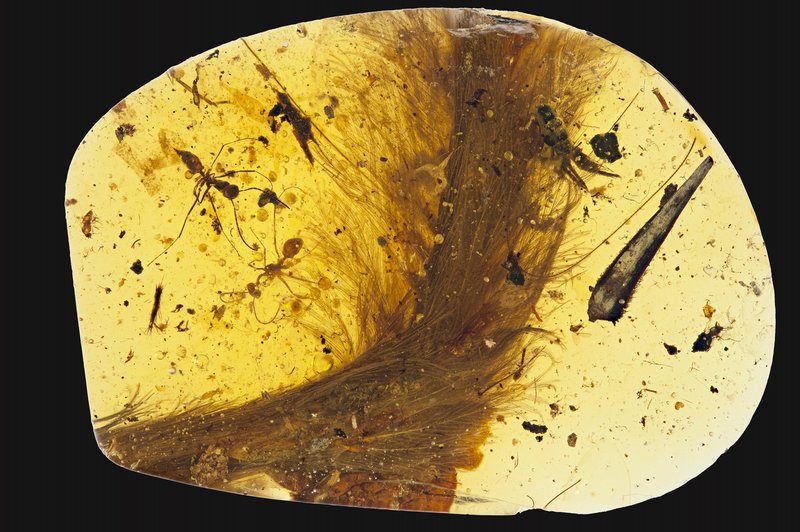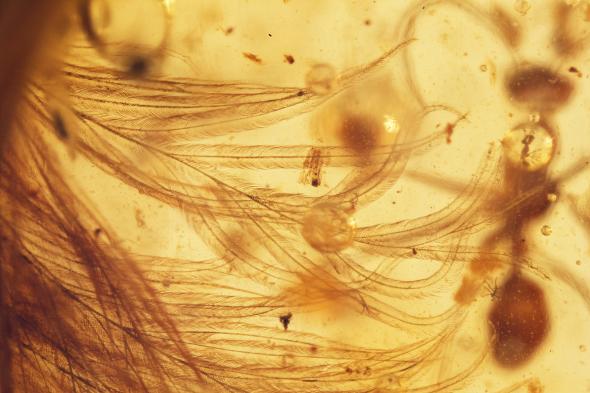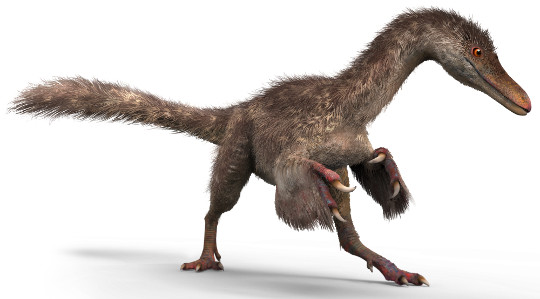
In 2015, while browsing at a market in Myanmar, Lida Xing, a paleontologist at Beijing’s China University of Geosciences, was offered a piece of amber. Believed to contain a preserved plant, it was meant for use as jewelry. Suspecting that the semitranslucent precious stone was harboring something more valuable, the scientist convinced the Dexu Institute of Paleontology to purchase it.
He was right. Alongside the insect and plant debris trapped inside the apricot-sized stone was a tail. Measuring 1.4-inches long, it was covered in delicate feathers that were reddish-brown along the upper surface and paler underneath. Microscopic examinations and CT scans revealed eight complete vertebrae encased by soft tissues like skin, ligaments, and muscles. The researchers suspect that the slim fossil is probably the middle or end of a longer tail that comprised more than 25 vertebrae.

The structure of the tailbone, which consisted of a string of vertebrae, eliminated the possibility that the fossil may have belonged to a prehistoric bird. That’s because modern birds and their closest Cretaceous ancestors have fused tail vertebrae, or pygostyles, that enable tail feathers to move as a single unit. Also, the feathers were different from those of Cretaceous-era birds. Instead of spurting from a strong central shaft, called a rachis, they were fuzzy barbs that were probably ornamental and used for temperature regulation and camouflage, rather than flying.
Xing and Ryan McKellar, a paleontologist at Canada’s Royal Saskatchewan Museum, who co-wrote the study published in Current Biology in December 2016, believe that the tail belonged to a non-avian dinosaur, most likely a juvenile coelurosaur that roamed our planet 99-million years ago. Though related to the fierce velociraptors and the Tyrannosaurus rex, the tiny coelurosaur, which could easily fit inside a human palm, had more in common with birds.

The scientists speculate the little dinosaur, nicknamed “Eva,” most likely got a portion of its tail stuck in tree resin. Since dinosaurs could not shed their tails like lizards, it probably died soon after. The resin hardened into amber and kept the tail in pristine condition for millions of years.
While researchers have previously found fossilized dinosaur feathers, they have always been compressed and distorted, making it difficult to recreate 3D images of the animal. Additionally, the lack of skeletal fossils made it impossible to identify the species associated with the feathers. “Eva” is the first non-avian dinosaur bone, muscle, and feathers all found in one place.

Interestingly enough, it was an amber-preserved mosquito with dinosaur blood in its belly which led to the cloning of the ancient creatures in the Jurassic Park. Thankfully, McKellar and Xing, who also found feathers from two Cretaceous-era birds encased in amber at the same market, have no such aspirations. They just want to use the discoveries to further our knowledge of dinosaurs.
Resources: Nationalgeographic.com, theverge.com,sciencemag.com,sciencedaily.com